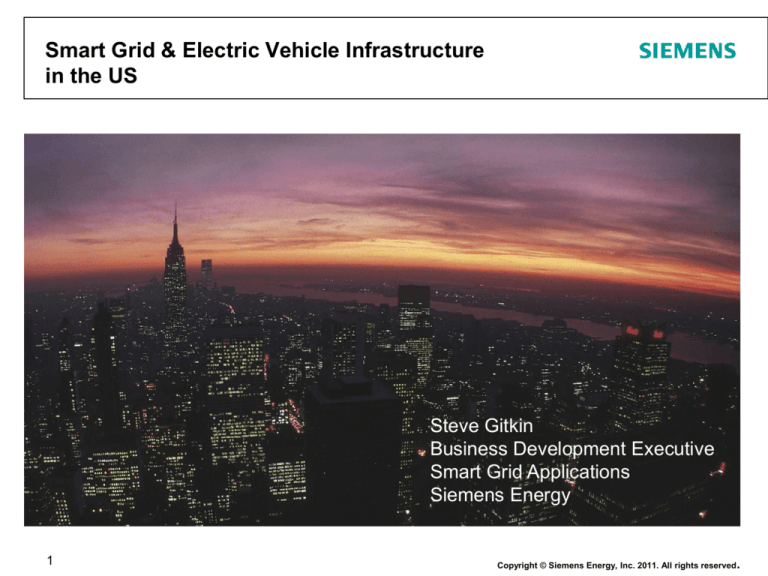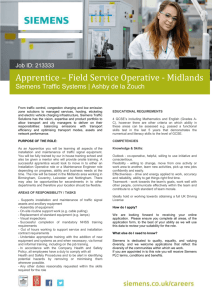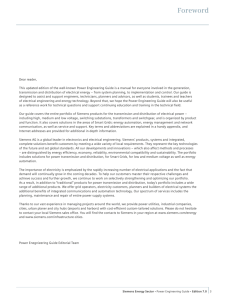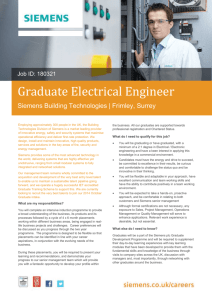
Smart Grid & Electric Vehicle Infrastructure
in the US
Steve Gitkin
Business Development Executive
Smart Grid Applications
Siemens Energy
1
Copyright © Siemens Energy, Inc. 2011. All rights reserved.
The world is changing – How to ensure a reliable,
ecological and affordable energy supply?
Demographic dynamics
Scarce resources
Climate change
■ Population growth
7.5 bill. in 2020 (+1.1 bill.)
■ Megacities (>10 mill. people)
27 megacities by 2025
■ Geopolitics
70% of global oil and gas
reserves are located in just
a few countries
■ Oil price fluctuations
■ Climate goals
Political programs aimed at
long-term reduction in
CO2 emissions
Source: UNO
Rising
energy consumption
2
Due to efficiency increases:
Growing electrification of
society
Growing
demand for
“clean” electricity
Copyright © Siemens Energy, Inc. 2011. All rights reserved.
Today’s Grid
Before
One-way limited communication
Few sensors and analog control
One-way power flow
Little to no consumer choice
No electric vehicles
Reactive maintenance
Centralized generation
Limited usage transparency
3
Copyright © Siemens Energy, Inc. 2011. All rights reserved.
If You Tried to Scale the Grid Directly (1/2)
Growing demand
33,000 TWh
+63%
Renewables
20,300 TWh
68%
2008
Nuclear
Fossil energy
sources
The growing demand is
stretching the US's power
grid to it's limit.
54%
2030
Increasingly distributed generation
The grid's infrastructure was
not intended for power to flow
bi-directionally.
4
Copyright © Siemens Energy, Inc. 2011. All rights reserved.
If You Tried to Scale the Grid Directly (2/2)
Infrastructure Reliability & Security
T&D equipment is built to last
40 years The average age
of U.S. T&D equipment is 42
years.
Blackouts cost Americans an
estimated $150 billion/year.
Millions of eCars
Without innovation, ~160 new
US power plants will need to be
built by 2020 to support eCar
adoption.
5
Copyright © Siemens Energy, Inc. 2011. All rights reserved.
Tomorrow's Grid
Bi-directional communication
and metering
Bi-directional power flow
Pervasive monitoring and digital control
Self-monitoring & high visibility
Many consumer choices
Millions of electric vehicles
Condition-based maintenance
Applications
Proliferation of numerous applications
After
Power
Information
6
Copyright © Siemens Energy, Inc. 2011. All rights reserved.
Tomorrow's Smart Grid Enables Flexibility …
Opportunities for Siemens (1/2)
Growing demand
33,000 TWh
+63%
Renewables
20,300 TWh
68%
2008
Nuclear
Fossil energy
sources
Smart Grid will increase
energy efficiency, shift load to
off-peak, and reduce demand.
54%
2030
Increasingly distributed generation
Smart Grid will allow energy to
flow bi-directionally.
7
Copyright © Siemens Energy, Inc. 2011. All rights reserved.
Tomorrow's Smart Grid Enables Flexibility …
Opportunities for Siemens (2/2)
Infrastructure Reliability & Security
Smart Grid will drastically
reduce blackouts by enabling
a "self healing" grid.
Millions of eCars
Smart Grid innovation has the
potential to dramatically reduce
the need for new power plants
to be built by using "smart
charging."
8
Copyright © Siemens Energy, Inc. 2011. All rights reserved.
Why Should I care about the Smart Grid?
The cost of building a Smart Grid in the United States will be $165 billion over the next
two decades, or $8 billion per year.
Electricity prices have increased by 54% in the last decade.
A 5% drop in peak-energy demand would eliminate the need for 625 peaker plants in the United
States – an annual $3 billion savings.
One typical electric-drive vehicle can put out over 10 kW, the average draw of 10 houses.
It will create business opportunities (like the internet did)
Smart Grid will create roughly 280,000 new jobs in the U.S. over the next four years.
2010-12-15
Confidential / © Siemens IT Solutions and Services, Inc. 2010. All rights reserved.
Siemens IT Solutions and Services / US
Electric Vehicle Infrastructure in the US
eMobility:
Smart Grids will bring
eCars to start.
Charging periods will be reduced and electricity
will become cheaper.
Millions of eCars will depend on grids as
consumers, and also serve as storage units.
A new power infrastructure has to be constructed:
charging units, public charging stations, eParking
garages, battery sweeping stations.
eCars will stabilize the grid as mobile energy
storage units and counteract power failures
caused by fluctuation.
10
Copyright © Siemens Energy, Inc. 2011. All rights reserved.
Electric Vehicle Roll Out Schedule
EV Project cities:
• Phoenix, AZ
• Tucson, AZ
• San Diego, CA
• Los Angeles, CA
• San Francisco, CA
• Washington, DC
• Portland, OR
• Eugene, OR
• Corvallis, OR
• Salem, OR
• Nashville, TN
• Memphis, TN
• Knoxville, TN
• Chattanooga, TN
• Dallas/Ft. Worth, TX
• Houston, TX
• Seattle, WA
•Southern MI
•New York, NY
•Orlando, Fl
•Washington DC
•Sacramento, CA
•San Jose/San Francisco
Bay Area
•Bellevue/Redmond, WA
•Austin, TX
•Baltimore, MD
2010-12-15
•Tampa,
FL reserved.
Confidential / © Siemens IT Solutions and Services, Inc. 2010. All
rights
•Boston, MA
Siemens IT Solutions and Services / US
The cars are coming………..
2010
2011
Nissan
Leaf
iMiEV
Toyota
Prius*
Chevy
Volt*
Audi
A1 e-tron
Smart
ED
Tesla
Roadster
Ford
Focus EV
Ford
Escape
Coda
Sedan
Mercedes
A-Class
Honda
Fit EV
Fisker
Karma*
BMW
Active E
Volvo
C30 EV
BYD
F3DM*
Th!nk
City
Transit
Connect
12
2012
The Obama-Biden comprehensive
New Energy for America plan will
put 1 million plug-in hybrid cars on
the road by 2015
* - PHEV or Extended range EV
Source: www.pluginamerica.org/vehicles/ and
various other sites
Copyright © Siemens Energy, Inc. 2011. All rights reserved.
Electric vehicles will initially be plugged-in in
certain markets
Predicted US EV and EVSE sales 2010 – 2015
Implications
Cumulative EV sales
(000 units)
Cumulative EVSE
sales (000 units)
800
728
1250
700
1000
600
492
500
750
400
1126
280
500
300
EVs will initially be launched
in specific states
Expect nearly 750K EVs
by 2015 and over 1.1M
EVSE units
We consequently expect
higher concentrations of
EVSE in these states
Utilities must implement
infrastructure now to support
the increased power
demand caused by EVs
771
200
130
454
151
100
4
0
2010
36
211
237
94
227
74
32
2011
250
0
2012
2013
2014
2015
Source: Smart Grid Applications, US; Global Insights
Target launch states
13
Copyright © Siemens Energy, Inc. 2011. All rights reserved.
We are in the Electromobility
charging infrastructure business
Use cases for electric vehicle charging
Home charging
Semi-public charging Public charging
■ EV owner charges car
at home
■ EV owner charges at
work in restricted areas
■ EV owner charges in
public spaces
■ Charging mostly with
wallboxes
■ Charging mostly with
wallboxes and CPs
■ Charging mostly
with CPs
Use
cases
Dscription
CP: Charging Point
Source: SGA-EM Sales Setup
2010-12-15
Confidential / © Siemens IT Solutions and Services, Inc. 2010. All rights reserved.
Siemens IT Solutions and Services / US
AC and DC charging require specific
charging hardware
Differences between L1 AC, L2 AC, and L3 DC charging
L1 AC charging
L2 AC charging
L3 DC charging
+
Simple and cheap (normal
household outlet sufficient)
+
Fast charging (~2-4 hrs)
+
Very fast charging (~30 min)
−
Long charging time (~8-10
hrs)
−
Charging time still too long
−
Expensive high power charger
1) Basic charger: AC 3.7 kW
Source: SGA-EM Sales Setup
2) Advanced charger: AC 22.2 kW
2010-12-15
3) High-power charger: DC 50 kW
Confidential / © Siemens IT Solutions and Services, Inc. 2010. All rights reserved.
Siemens IT Solutions and Services / US
Siemens product portfolio covers wide range of
applications for Electromobility - Globally
Siemens parking and charging infrastructure hardware
Epos
Charge (AC)
CP500A CP510A
SAE, CCC
SAE
Home charging
(Semi-)
Public charging
Park &
WB500A
SAE
CP500A
IEC
WB300A
IEC, SAE
Charge (DC)
CP700A
IEC, CCC
WB300D
IEC,
CHAdeMO
CP500D
IEC, SAE,
CHAdeMO
Wallbox
IEC
Available
Epos: Electronic Point Of Sale
Source: E D SGA-EM PLM
16
ST500D
IEC, SAE,
CHAdeMO
Available from 2011/2012
CP: Charging Point
Copyright © Siemens Energy, Inc. 2011. All rights reserved.
Siemens Electromobility
infrastructure has different layers
Siemens Electromobility infrastructure portfolio overview
Fleet management
+
Solution
and
system
integration
Services
and
operation Energy management
center
Installation and maintenance
=
+
EV
interface:
charging
infrastructure
EM
software
platform
Charging
hardware
EM: Electromobility
BEV: Battery Electric Vehicle
Source: SGA-EM Sales Setup
17
Customer portal
■ Operation and monitoring of hardware
■ IT-solutions for service applications
■ AC, DC, inductive charging, and
swapping hardware to charge BEVs
and PHEVs
PHEV: Plug-in Hybrid Electric Vehicle
Copyright © Siemens Energy, Inc. 2011. All rights reserved.
Real Life Implementations
CP: Charging Point
Source: SGA-EM Sales Setup
2010-12-15
Confidential / © Siemens IT Solutions and Services, Inc. 2010. All rights reserved.
Siemens IT Solutions and Services / US
04.11.2011
Confidential / © Siemens AG 2011. All rights reserved









